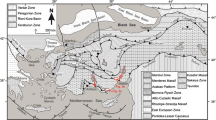Abstract.
The stratigraphy of the uppermost levels of the Menderes Massif is controversial and within its details lie vital constraints to the tectonic evolution of south-western Turkey. Our primary study was carried out in four reference areas along the southern and eastern Menderes Massif. These areas lie in the upper part of the Menderes metamorphic cover and have a clear stratigraphic relationship and contain datable fossils. The first one, in the Akbük–Milas area, is located south-east of Bafa Lake where the Milas, then Kızılağaç and Kazıklı formations are well exposed. There, the Milas formation grades upwards into the Kızılağaç formation. The contact between the Kızılağaç and the overlying Kazıklı formation is not clearly seen but is interpreted as an unconformity. The Milas and Kızılağaç formations are also found north of Muğla, in the region of Yatağan and Kavaklıdere. In these areas, the Milas formation consists of schists and conformably overlying platform-type, emery and rudist-bearing marbles. Rudists form the main palaeontological data from which a Santonian–Campanian age is indicated. The Kızılağaç formation is characterized by reddish–greyish pelagic marbles with marly-pelitic interlayers and coarsening up debris flow deposits. Pelagic marbles within the formation contain planktonic foraminifera and nanoplankton of late Campanian to late Maastrichtian age. The Kazıklı formation is of flysch type and includes carbonate blocks. Planktonic foraminifera of Middle Palaeocene age are present in carbonate lenses within the formation. In the Serinhisar–Tavas area, Mesozoic platform-type marbles (Yılanlı formation) belonging to the cover series of the Menderes Massif exhibit an imbricated internal structure. Two rudist levels can be distinguished in the uppermost part of the formation: the first indicates a middle-late Cenomanian age and the upper one is Santonian to Campanian in age. These marbles are unconformably covered by the Palaeocene–Early Eocene Zeybekölentepe formation with polygenetic breccias. In the Çal–Denizli area, the Menderes massif succession consists of cherty marbles and clastic rocks with metavolcanic lenses. The Lower–Middle Eocene Şalvan formation lies unconformably on this sequence and is interpreted as equivalent to the marble horizons at Serinhisar but with pelagic facies. The Şalvan formation consists of shale, mafic volcanic rock, lenses of limestone and blocks of recrystallized limestone. The Şalvan formation is dated here for the first time by Early–Middle Eocene foraminifera and nanoplankton from the matrix of the formation. An angular unconformity exists between the Upper Cretaceous and Lower Tertiary sequences, suggesting that a phase of deformation affected the southern and eastern part of the Menderes Massif at this time. This deformation may be caused by initial obduction of the Lycian ophiolite onto the passive margin to the north of the Menderes carbonate platform during the latest Cretaceous. Drowning of the platform led to termination of carbonate deposition and deposition of deep water flysch-like clastic sediments.
Similar content being viewed by others
Author information
Authors and Affiliations
Additional information
Electronic Publication
Rights and permissions
About this article
Cite this article
Özer, S., Sözbilir, H., Özkar, İ. et al. Stratigraphy of Upper Cretaceous–Palaeogene sequences in the southern and eastern Menderes Massif (western Turkey). Int J Earth Sci 89, 852–866 (2001). https://doi.org/10.1007/s005310000142
Received:
Accepted:
Issue Date:
DOI: https://doi.org/10.1007/s005310000142




